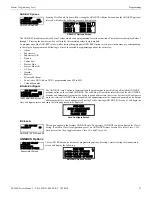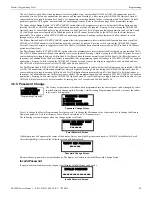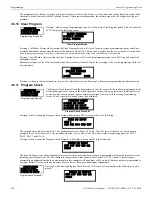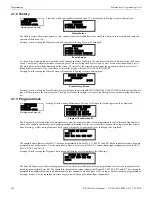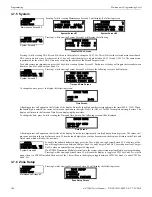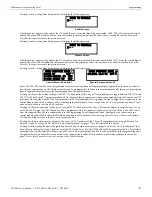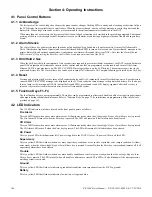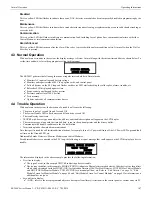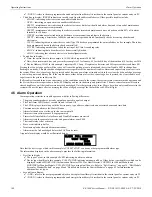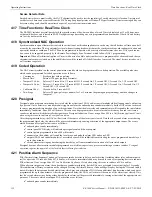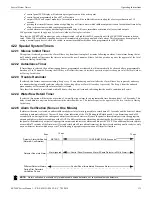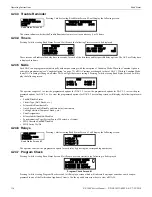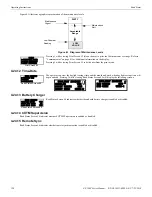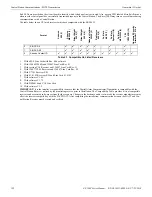
ES-200X Series Manual —
P/N LS10131-000FL-E:C 7/25/2018
111
Mass Notification Operation
Operating Instructions
•
Timers are not started
•
Store event in history buffer
•
Activate appropriate LED on the ANN-LED annunciator (required for this application)
•
Each ANN-LED can support up to 10 zones.
Medical alert conditions latch. They can be assigned to software zones.
4.11 Mass Notification Operation
The FACP may be installed with an ECC-50/100 audio system to provide mass notification operation. The FACP must control the ECC-
50/100 via the ANN-BUS. Refer to “Automatic Audio Panel Control” on page 47 for details and wiring information.
Some mass notification installations may require that the activation of the audio system results in an override of an active fire notifica-
tion at the FACP. This is determined by a risk assessment in accordance with the local AHJ. The FACP provides the flexibility to accom-
modate override or non-override operation. For override operation, FACP NACs and/or other SLC control modules may be deactivated
while the mass notification event is active. No other FACP operation is overridden or interrupted. If override operation has been selected,
notification for a fire event will resume upon termination of the mass notification event at the audio system.
When mass notification override is enabled, mass notification alarms will result in a mass notification event being sent to the central sta-
tion. An event code can also be sent indicating which message is playing on the audio system. Message event code transmission must be
enabled in programming.
Refer to page 80 for programming mass notification override at the system level.
Refer to page 68 for programming mass notification override for SLC control modules.
Refer to page 78 for programming mass notification override for onboard NACs.
Refer to page 86 for programming message event code transmission to the central station.
4.12 NAC Operation
There are four programmable NACs (Notification Appliance Circuits) resident on the ES-200X main circuit board. All NACs may be
programmed as silenceable or nonsilenceable and may also be programmed for steady or coded operation. Coded operation provides a
choice between March Time, Temporal or California coding.
4.13 Programmed Zone Operation
Each addressable detector and monitor module can be assigned to a maximum of five software alarm zones. A general alarm zone Z000
may be listed for output (control) points, but it is not necessary to list Z000 for input points, since this is the default zone for all alarm
input devices. Zone Z000 is not activated by supervisory points.
When an input device alarms and is not disabled, it activates all software zones assigned to it. An output device that is not disabled is
turned on when any of the software zones to which it is programmed become active. Only alarms, hazards/tornado alerts can turn on any
of the four main NACs.
4.14 Disable/Enable Operation
Input points which are disabled do not cause an alarm or any zone activation. Disabled output points are held in the off state. All disabled
points are treated as if they were in trouble, with the exception being the status label that will be displayed is
DISABL
.
4.15 Waterflow Circuits Operation
If an alarm exists from a monitor module point that has a waterflow type code and its mapped NAC control module outputs are pro-
grammed for nonsilenceable operation, the Alarm Silence key will not function. Also, any output zone activated by a waterflow device
will not be silenceable if the Waterflow Silenceable option is set to NO in system programming.
4.16 Detector Functions
Maintenance Alert
Each addressable detector is monitored by the control panel for its maintenance status. If a detector is near but below the allowed alarm
limit, a ‘maintenance alert’ message will automatically be displayed, signaling that the detector is in need of servicing.
Automatic Test Operation
An automatic test of an addressable detector is performed each minute, resulting in a complete SLC loop test in approximately 5 hours (if
the loop has the maximum number of devices installed). The detector’s sensing chamber and electronics are functionally tested for nor-
mal, safe operation. A trouble message is displayed upon failure of this test. A System Reset will clear this trouble.
Type Code Supervision
The FACP monitors addressable hardware device codes at slow intervals. Mismatch of any type code, compared to the system program,
will cause a device trouble.
System Alarm Verification
The control panel may be programmed to perform alarm verification to help eliminate the nuisance of false alarms. Alarm verification
applies to smoke detectors only.

